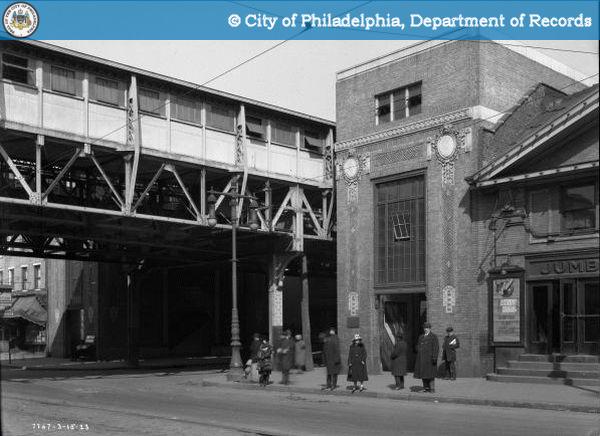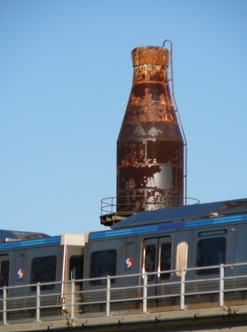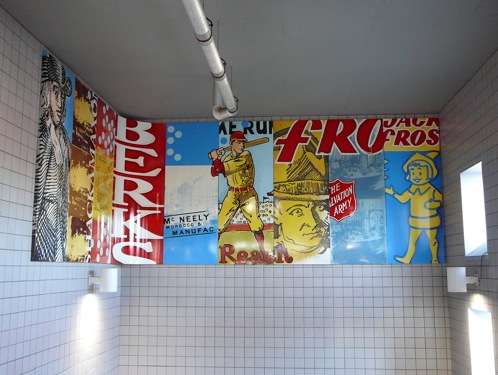
Girard Station, northeast corner Front Street & Girard Avenue, in 1923. Jumbo Theatre is to right.
Frankford Elevated, 1915
various locations between Old City and Frankford, Philadelphia PA
© Carmen A. Weber, Irving
Kosmin, and Muriel Kirkpatrick, Workshop of the World (Oliver
Evans Press, 1990).
The Frankford Elevated was
begun in 1915 with a scheduled completion date of 1918.
It opened in November 1922, its construction cost more
than twice the original estimate; both the delay of
construction and the rise in cost were attributed to
World War I. The "El" proved popular and it drew enough
business from the railroad to force the closing of the
Frankford Station of the Reading Railroad in June, 1928.
The Frankford El is the northeast extension of the
Market-Frankford subway elevated line which runs from
center city Philadelphia west to 69th Street in Upper
Darby and east to Frankford. The Frankford El exits the
subway just north of Vine Street and continues
northeasterly through Old City, Northern Liberties,
Kensington (including Harrowgate), and ends in Frankford
at Bridge-Pratt Terminal.
The heavily traveled El has the highest passenger load of
any line in the Philadelphia metropolitan region; its
100,000 daily ridership exceeds that of the entire
suburban commuter system. The existing El has three basic
structural components: a double column viaduct (84% of
the line); a single column viaduct; and three major
structures—the Amtrak, Conrail, and Lehigh (Avenue)
bridges.
Deterioration of the El has long been observed and
studied and as a result the line is being extensively
restored. The work involves rebuilding to modern
standards 5.25 miles of elevated structure carrying a
very old and very active double track railroad system. In
addition, the three major bridges are to be rebuilt with
plans to replace or to rehabilitate eleven passenger
stations.

Update
May 2007 (by Torben
Jenk):
The track and supports
have been substantially rebuilt along with most of
the stations to comply with modern accessibility
standards. The modern aesthetic includes glazed
structural tile, woven stainless wire railings, and
cast-in place concrete, resembling a prison.
Renovated and adapted, only a few original buildings
survive at Bridge & Pratt (the former entrance),
Oxford Street (electric substation?), and Tioga (a
superb work of buff brick laid in Monk Bond with
limestone highlights, facing the park to the
southeast). Spring Garden Station was modernized
earlier (in the 1970s?) while all the other stations
above Second Street were built within the last
decade, including Girard, Berks, York-Dauphin,
Hungdon, Somerset, Kensington & Allegheny, Erie
Torresdale, and Church.

SEPTA has
commissioned works for its "Art in Transit" program.
Tiled murals are at York-Dauphin and Church. Holographic
glass finials rise above the platform at Bridge &
Pratt. Artist Jeff Schaller designed, silkscreened, and
installed huge panels at Berks Station to share the
history of Kensington through images of William Penn,
Penn Treaty, McNeely Morocco, Salvation Army, Reach
baseballs, Stetson hats, Jack Frost sugar and Cramp Ship.
See
also:
Workshop
of the World Market-Frankford
El.